SpinFit eartips review: the good difference – Soundphile Review
When I started using in-ear headphones, around a decade ago, one of the things that I didn’t like about the experience was the eartips. They were just too uncomfortable compared to classic earbuds with foams. Sure, they provided better isolation, but having very sensitive skin I often found myself with irritated ears. Then I discovered foam eartips and that changed things completely, as they were much more comfortable, as isolating as the silicone ones and less prone to cause irritation. So I basically stopped using silicone tips – why bother when the foam ones were so much better for me? But one of the realities of life is that things change, sometimes for the worse and (thankfully) sometimes for the better, and man did my perception of silicone tips change when I discovered the SpinFit tips.
I’d heard about SpinFit tips a lot, but I never had a chance to try these eartips everyone was raving about. Then, I was contacted by the incredibly kind Chia-yin back in December. She offered to send me a few eartips and after a couple of e-mails we decided it would be interesting to try out the whole range of SpinFit eartips, so she sent me the entire line-up in all the available sizes. Much to my surprise, these tips are just as good as the foam ones thanks to the way they are built.
Disclaimer: SpinFit sent me these tips for free in exchange for my opinion on them. Additional information is available on the official website.
Mục Lục
How and why SpinFit eartips work

The basic idea underlying every SpinFit eartip model is the following: traditional eartips have a straight solid core at their centre which stays so independently of the actual shape of the ear, but it would be better if the core could bend and follow the curves of the ear canal. This is what happens with the SpinFit tips: there is a point in which the silicone is thinner and therefore softer and it’s shaped like a doughnut, so that it can bend and provide better comfort.
It’s quite a simple trick but, believe it or not, it makes a world of difference. That’s because the eartips adapts to your ears instead of the other way around, so you get better comfort not only in the long run, but in the short term as well, plus better isolation too. It’s such a great and simple idea in hindsight that one has to wonder why nobody else thought about it before.
Everything else is the same as on “normal” silicone eartips, which is also why the SpinFit tips are so great: you get all the pros (good isolation, washability and basically eternal durability, wide compatibility) with none of the cons.
The inner bore is made of harder (but still soft in absolute terms) silicone, usually with a colour that allows you to distinguish between the various sizes. The rest is made of transparent silicone in most cases, though on a couple of models it is black. It’s a very soft and malleable silicone that bends easily so that it adapts well to the shape of your ear canals. In other words, the comfort should be better compared to usual tips.
A small note: I am going to compare the various eartips using the “L” size as reference, so you will need adjust that to the size you are interested in as the purpose is to give you a frame for comparison, not to describe every possible size and combination.
Let’s take a look at the various models then!
SpinFit CP100
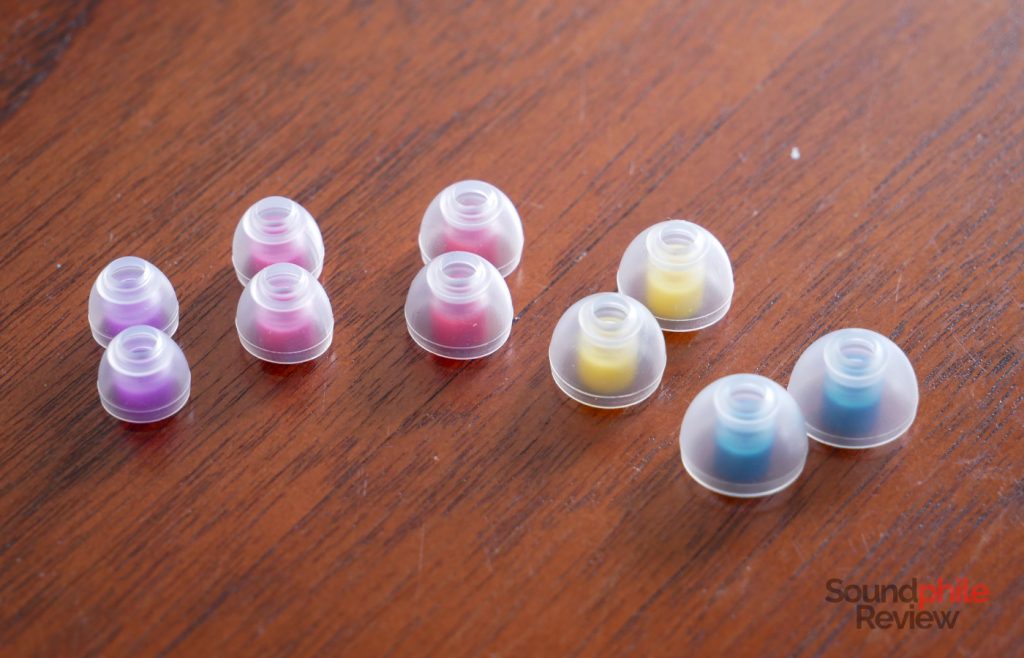
The SpinFit CP100 are the basic model, which by shape and feel most closely resemble “standard” eartips. They are conical (a wide ogive, to be exact) and offer a diameter of 4 mm which fits most earphones (including the Campfire Audio Vega 2020 and Dorado 2020, the Thieaudio Legacy 4, the Tin HiFi T2), but which is also a bit tight for earphones with larger nozzles. Still, they’re the ones that will probably fit the larger number of earphones, as they do just fine even with those that have a smaller nozzle like the Legacy 4. They come in 5 different sizes: SS (XS would have probably been better), S, M, L and XL.
The peculiarity of the CP100 is that they are tall (9.9 mm), but they are actually quite wider at 13.3 mm. This means that they won’t need to go very deep to seal off your ear canal and therefore will also be fine for earphones with short nozzles. Thanks to this good seal, bass is well extended and controlled, while the rest of the range comes out as well balanced and with no particular colouration and the same sensation of good control as in the lower area. As a whole, the sound is mostly unaltered and this also includes the “bad” side of this, as the tips won’t reduce peaks e.g. in the treble area.
From a comfort perspective, I found the CP100 to be quite good in general as I could wear them for a long time without feeling fatigue, pressure or discomfort more in general. The only negative aspect is that sometimes the tips act as suckers (or suction cups, if you live on the other side of the pond), which causes what is honestly a quite uncomfortable feeling. It doesn’t happen always, though, and it’s easy to avoid by extracting the earphones from your ears at an angle.
SpinFit CP100+

The SpinFit CP100+ (or CP100 Plus) are the exact same as the CP100 in terms of size, but they are made with a different material. They keep the same diameter of 4 mm and the same variety of sizes (SS, S, M, L, XL), but they are made of medical-grade silicone and feature more subdued colours and a more transparent dome.
They are equivalent to the CP100 in every respect, except for sound: the new material makes treble a bit stronger overall.
SpinFit CP145
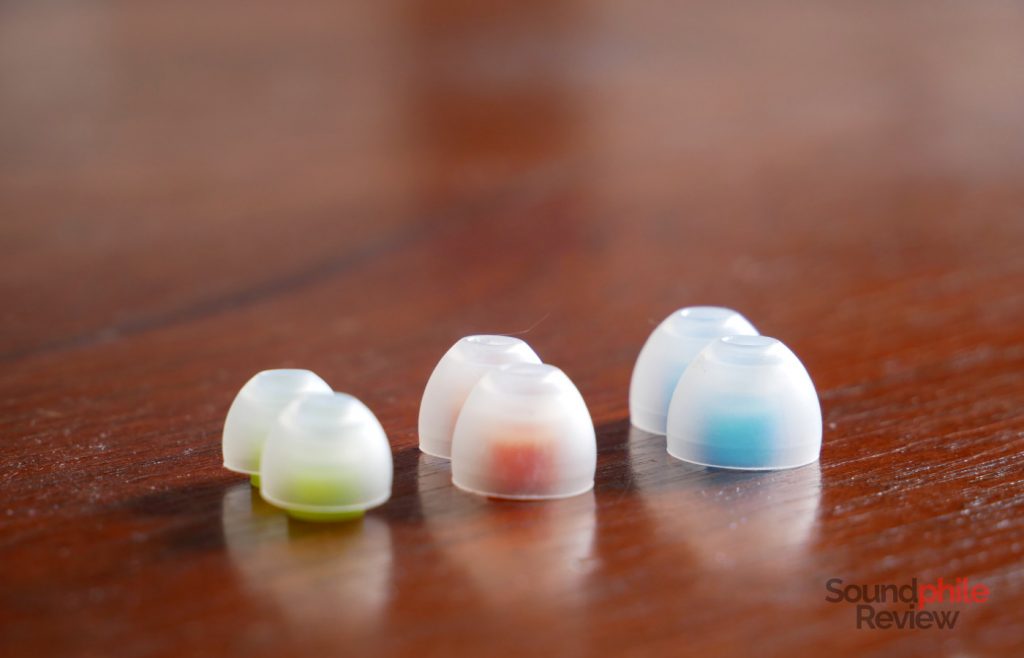
The SpinFit CP145 are much like the CP100, but they have a smaller top so they go better inside the ear. The difference is not dramatic in terms of size, but the fit is quite different. The general shape is again ogival, with a height of of 10.1 mm and a with of 13.5 mm. With an inner diameter of 4.5 mm, the CP145 can fit earphones with nozzles up to 5.5/6 mm in diameter: that means that even IEMs with larger soundports, like the Tin HiFi P2, Shanling ME500 Platinum, Fearless Audio S10 Genie or Moondrop A8 will fit correctly, though the silicone will stretch a bit. There are just three sizes: S, M and L.
The CP145 seem to tame bass a tiny bit to give a small boost to the upper midrange and to treble; mind you, we’re talking about a difference that’s not major and is in fact relatively minute. In other words, you won’t be able to make a warm IEM a neutral one, but you will notice a smaller difference compared to other tips. Overall my sensation is that the CP145 deliver a wider soundstage, probably thanks to the larger presence in the upper area, and more accurate imaging compared to the CP100. They still deliver a generally neutral signature.
They’re quite comfortable and in fact I find them to be slightly more comfortable than the CP100, because they fit more snugly in my ears. They’re the closest equivalent I have found among silicone tips to the sensation foam eartips give me: that my ear canal is sealed by something that fits snugly in it while respecting its shape and boundaries. In other words, it doesn’t feel like something that gets inside my ears while trying to impose its presence, asking my ear canal to adapt to it, but it feels like something that fits in the canal trying to take the space in there and nothing more. It’s a weird sensation that’s very difficult to describe, but I hope I somehow gave you an idea.
It’s not only a matter of comfort: the CP145 prove to be great at passive isolation as well. As they seal off the ear canal quite well, the side effect is also that there is an almost-perfect level of isolation. Although the overall isolation is of course dependent on the earphones as well, these eartips make a real difference and shut most of the noise out.
SpinFit CP155

The SpinFit CP155 are akin to the CP145, but they’re made to fit the earphones having the largest nozzles, thanks to an inner diameter of 5.5 mm. They are the tallest so far, with a height of 11 mm and a width of 13 mm, and they are the ones that go deepest in the ear canal as they have quite a pointy tip with a smaller hole than that on the CP145. They come in three sizes (S/M/L) and perfectly fit earphones like the Moondrop A8 and Shuoer Tape Pro, which have very large nozzles. The CP155 are made with black silicone, with the inner bore being coloured.
As they get the deepest inside the ears, the CP155 are also the ones I’ve found myself the least comfortable with on the first try. It takes around five minutes for the silicone to warm up and for my ears to adapt, but then it’s almost as if I wasn’t wearing them at all. Due to their shape they offer an almost perfect seal, so if the earphones you’re wearing provide any isolation at all you probably won’t hear a thing of what’s around you without needing active noise cancellation.
Soundwise, the CP155 are neutral and I can’t hear significant differences when compared to the CP100. If anything, the better seal allows bass to get further down, but it’s a minimal difference which is highly dependent on the earphones you are listening to.
SpinFit CP240
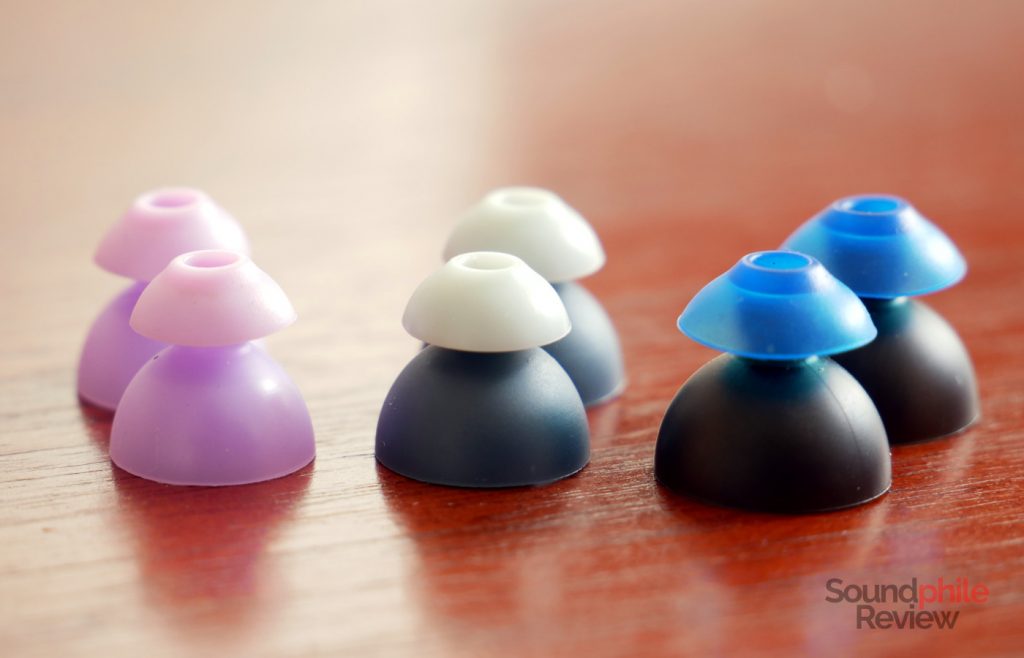
The SpinFit CP240 are the only ones in the manufacturer’s line-up to feature two flanges. They say that these tips offer “triple flange isolation without the violating insertion feel” – which is exactly how I would describe the sensation of wearing triple flanges. The CP240 are quite taller than the other eartips in the line-up at 13.3 mm, and they’re also the widest at 14.7 mm (12.2 mm for the smaller flange). They have a diameter of 4 mm and there is also an insert (which I didn’t receive) which allows you to use the CP240 with earphones having a nozzle diameter of 3 mm or less, so that you can take advantage of the double flange even with earphones made by Shure or Etymotic. This is the other one of those cases I mentioned where the silicone is not transparent or white, as it is in two tones of pink for the small size, in dark and light grey for the medium one and black and blue for the large one.
SpinFit is right in saying that these eartips offer triple flange-like isolation and this has also an impact on the sound: the world around you basically disappears, as long as you are in a moderately noisy environment (very noisy environments can still be a problem). Even keeping the volume of music very low, I can’t hear the Gateron Black switches of my keyboard (and, trust me, in a silent room they are definitely audible!). This makes music sound better as it has less background noise to contend your attention with. My impression is that the CP240 reduce the volume a bit and also reduce the presence of lower midrange, making it ever-so-slightly recessed. Sound becomes thinner and more concentrated in the upper range, also losing a bit of bass presence.
From the perspective of comfort, although they’re nowhere near the level of triple-flange tips, it still takes a bit to get used to them. They’re much longer than the other earphones and therefore get deeper in your ears, which may be a bit unsettling. I found it’s also a matter of inserting them at the right angle, as otherwise they become very uncomfortable and don’t sound good. If you get the insertion right, though, you get a great level of comfort. I find it inferior to the single-flange tips, but great for dual-flange ones.
SpinFit CP360
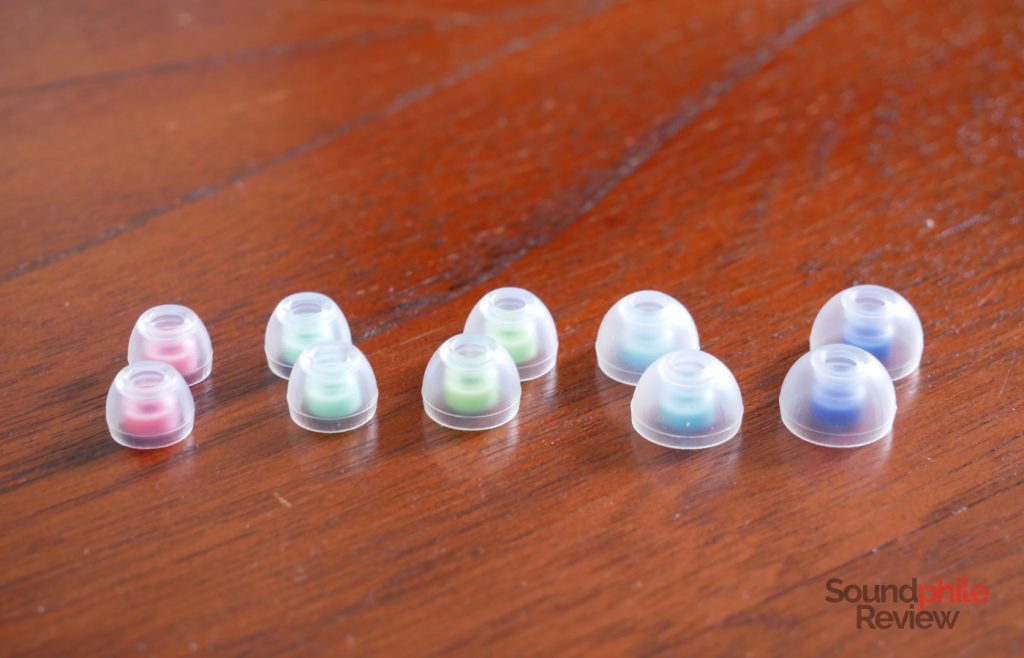
The SpinFit CP360 are the first tips SpinFit developed specifically for “true wireless” earphones: they’re much shorter than the others because they need to fit in the cases, which often offer very little space for eartips. This means they can’t count on the depth of the insertion to give you isolation and have instead to rely on width: the ear canal is larger at the entrance and so these eartips need to be wider to seal it. In fact these are among the few SpinFit models to offer an XL size (on top of L, M, S and SS) and that’s because of this. The L size is 13 mm in width and 8.5 mm in height, while the XL is even larger at 14 mm wide and 8.5 mm high. They are basically shorter CP100! That’s also true when you look at their shape, which is similar but more compact. The inner diameter is 3.6 mm.
Soundwise they are also quite close to the CP100, so they have very little impact (if any) on the sound and allow you to hear it as intended by the manufacturer of the earphones.
From a comfort perspective, the CP360 are a bit weird because it’s as if you were putting them halfway in. It’s just a matter of habit, because they’re actually quite comfortable and some people may even find them more comfortable than “traditional” eartips exactly because of their shallower fit. They do sometimes give me that “sucker effect” when I take them out. In terms of isolation they do a very good job as they seal the ear canal quite well, so there’s not much sound that comes in.
As a last bit, the silicone is actually medical grade, so the added benefit is you shouldn’t have issues with allergies and other adverse reactions.
SpinFit CP500

The SpinFit CP500 are basically CP155 with a slightly less conical shape and a groove on the inside of the inner bore. This groove fits around the lip of earphone nozzles to provide better stability and security. In other words, it won’t happen that the eartips remain stuck in your ears when you take out the earphones. The CP500 are 12 mm in diameter and 9.7 mm in height, with a diameter of the inner bore of 5.5 mm.
It’s the groove in the inner bore that makes the difference: it grips the lip of the nozzle much better than the usual smooth eartips and this provides better comfort, as the tip is more stable, while also providing a more uniform sound quality across earphones: the distance between the sound port and the end of the eartips is constant, so you get the optimal distance that SpinFit found. Speaking of sound, I find the CP500 to be neutral as they don’t modify the sound significantly – for better or for worse.
The silicone the CP500 are made of is slightly lighter and softer than the one used for the CP155, so I find them to be more comfortable as they adapt to my ear canals better. In fact I can wear them for a long time despite them reaching deeper in my ears than I’d like them to, because the softness is such that they don’t bother me at all. They are also quite easy to put in and they’re not finicky in that regard, while also not causing the “sucker effect” in any case.
SpinFit CP800

The SpinFit CP800 were the only ones I could not try due to not having compatible earphones: they are made for super-thin nozzles like those used by Shure, Westone and Etymotic. At just 2 mm wide, the inner bore is too narrow to house earphones with 4 mm nozzles (believe me, I tried). I will update this review as soon as I lay my hands on compatible earphones, but I expect them to behave exactly like all other eartips in this list.
SpinFit CP1025
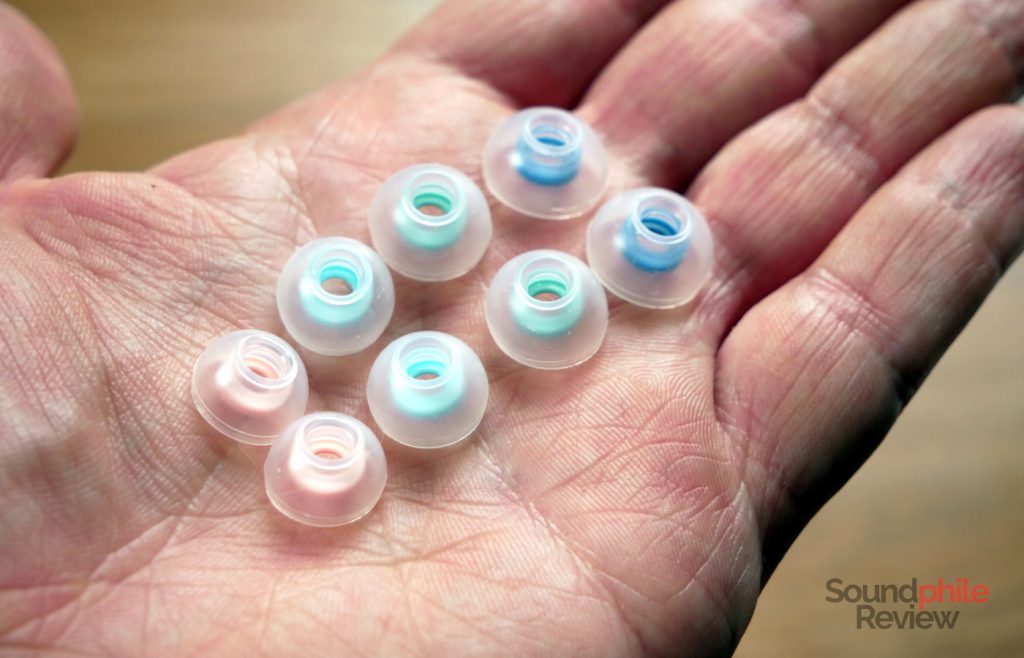
The SpinFit CP1025 were made to fit the Apple AirPods Pro thanks to an included adapter. The adapter is in fact an add-on that you can ignore completely if you use other earphones, and the CP1025 work just as well. In fact I think SpinFit should market this model not just for AirPods Pro as it – surprisingly – is also the one that I found to work best with other TWS as well, even more than the CP360. Update: SpinFit has actually done so, making the CP1025 available without the adapter and as more general TWS eartips. The CP1025 have an inner diameter of 3.6 mm and an outer diameter of 12 mm, with a height of 6.7 mm. There are four sizes available: L, ML, M and S.
The main differences with the CP360 are the height and the radius: the CP1025 are shorter and slightly narrower (12 x 6.7 mm vs 13 x 8.5 mm), so they don’t go all the way inside the ear canal but manage to seal it effectively thanks to their wide radius. This also means that they fit most charging cases better, as they are shorter.
As for sound, my impression is that they are quite neutral and I can’t hear significant differences compared to other tips like the CP100. This is actually desirable, so kudos to SpinFit!
The thing about the CP1025 is that they go less inside your ears, so they can be more comfortable in the end if you prefer a shallower fit. They also provide very good isolation for eartips of this kind and are comparable to eartips such as the CP100. I never found myself experiencing the “sucker effect” using these eartips. My eardrums appreciated the fact.
SpinFit told me that the silicone in this case is “edible grade”, so even though it’s probably best to not put these over your pasta you probably won’t have any allergic or otherwise adverse reactions to it.
SpinFit W1

This is a completely different kind of eartips compared to the rest. While the SpinFit W1 retain the patented wobbling mechanism, the inner bore is made with two different types of silicone which makes them stiffer and more stable than the other models. These tips have an inner diameter of 4.5 mm, which makes them compatible with the same earphones as the CP145 (so with nozzles up to 5.5/6 mm). The W1 is available in three sizes: S, M and L. They are all included in the package.
The main difference between the W1 and the other eartips by SpinFit is the dual-density silicone used to make the inner bore. It has a wave shape, hence the name. This makes the inner bore stiffer, plus it also makes it easier for it to grip earphones’ nozzles and therefore offers more stability. It is therefore advised to use the W1 for especially large and heavy earphones, as it will be difficult for the tips to come off.
In terms of sound, there’s not much of a difference with the CP145, though highs tend to be a bit more present (probably due to the material being harder and therefore more prone to reflecting higher frequencies).
The wearing experience is very similar to the CP145, but due to the additional stiffness they can feel a bit more fatiguing during long runs. While the dome is made of the same silicone, the different inner bore has a small impact on comfort.
Passive isolation is quite good, too: probably due to the relatively deep insertion and wide dome, the SpinFit W1 are quite successful at sealing off the ear canal and therefore offer great isolation.
Final Thoughts
Eartips do make a difference in our listening experience. They may not always have an influence on sound, but they do change the way you wear your earphones and this makes all the difference between listening to music while being comfortable and doing so while swearing against the pain in your ears. The SpinFit line-up is quite complete and gives you a lot of choice to get the eartips that better suit your needs, from very deep insertion to a very shallow one. All of them offer a great level of comfort, thanks to the soft silicone and to the incredibly clever design SpinFit came up with. SpinFit eartips are a game changer and can completely change (in a very positive way) the way you experience your favourite earphones.
The line-up is quite vast and choosing the right model can be difficult, but I hope it will be made easier by this review. Feel free to ask any questions in the comment section below!















![Toni Kroos là ai? [ sự thật về tiểu sử đầy đủ Toni Kroos ]](https://evbn.org/wp-content/uploads/New-Project-6635-1671934592.jpg)


